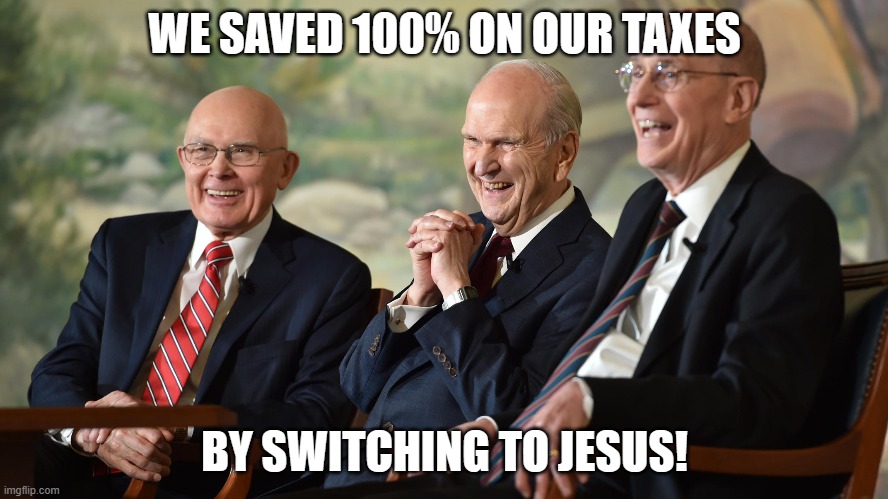Is that really true?The best estimates put the Church’s annual spending at about 4-5% of its savings. That level of spending of a fund’s principal may sound small to nonexperts, but it’s actually in line with what’s needed to continue to maintain the principal through inflation so that spending can stay consistent over time. It’s also precisely the level of spending most universities engage in relative to their endowments.
You could have just asked.
Nate Oman, a law professor at the College of William and Mary, writes:
The Church [of Jesus Christ] spends at exactly the rate it needs to spend in order to operate indefinitely. … It’s basically behaving exactly the way that we would expect that a large non-profit would behave. By the numbers, it’s normal.
Going to Nate Oman's blog, the source of this quote, he says:
Is he serious? Is this a prank blog post made by a cynical anti-Mormon trying to make believers look like dupes for believing this?I want to ask a simple, big picture question: Is the basic financial model of the Church unique or wildly different from that of other non-profits? Does it hoard wealth to an unusual degree?
This is a hard question to answer because of the Church’s secrecy (see my opinion above), but we have some numbers that are kicking around the news. I don’t know if they are correct, but they seem plausible to me. Here are the numbers:
Each year the Church takes in about $7 billion in tithing revenue, it spends about $6 billion, it puts about $1 billion into its savings, and it has savings of about $150 billion. These are big numbers, but the Church is a really big institution with millions of members in hundreds of countries. The question isn’t whether the numbers are big but whether the relationship between the numbers reveals something surprising or unique in the Church’s behavior.
Think about a large non-profit institution like a university.[1] It will also take in tax-exempt donations, which will be put in a university foundation. The university will spend a portion of its money from donations and the foundation each year. The goal is to create a kind of financial perpetual motion machine in which the institution can continue to operate indefinitely. No university that wishes to operate indefinitely spends all of its donations, living hand to mouth each year. That model would create a very fragile institution, and such institutions don’t live for centuries like, say, my employer, The College of William & Mary, which is 330 years old. (Go Tribe!) Institutions also don’t want to spend at a rate that will cause their foundation to diminish in value each year. Again, an institution that pursued this strategy would eventually find itself living hand to mouth, would become fragile, and ultimately fail. So the trick is to set spending at a level that can be maintained indefinitely, drawing money from the foundation without depleting it. What is that number?
The answer for most universities is 4 to 5 percent.
It’s a little more complicated than that because the size of foundations gyrates quite a bit with background market conditions, sometimes institutions in effect borrow against their own future revenues by ramping up spending for a period and then spending less in the future, and so on. But basically, you spend at 4 to 5 percent. If you are spending at 4 to 5 percent of your foundation value, that level of spending can be maintained indefinitely.
So let’s ignore all of the distinctions between the Church and Ensign Peak and money from tithing versus cash payouts from investments. Treat everything as one big organization. This makes sense, because while the distinctions between particular entities may be important in various legal contexts, they aren’t really all that important when it comes to thinking about Church finances at the macro level. All of these entities are controlled by the Council on the Disposition of Tithes, which also controls all Church spending. Cash is fungible.
So, how is the Church being managed? If the Church is spending $6 billion a year and has investments of $150 billion,[2] what is its rate of spending?
4 percent. Exactly 4 percent.
I’ll be honest. I am surprised by that number. I expected it to be smaller. In other words, I expected that the number would suggest that relative to other non-profits the Church was run really, really conservatively, spending far less relative to its reserves....
So my conclusion is that actually the Church’s basic financial structure isn’t particularly shocking or unique. It is not being managed in a way that suggests the mindless hoarding of wealth. It seems to be managed more or less exactly the way that a large conservatively managed institution that expects future growth and wishes to operate indefinitely would behave.
Using his numbers, the Church's spend rate isn't withdrawing 4 or 5 percent from the endowment. It's depositing 0.67%. And a negative 0.67% is a lot less than a positive 4 or 5 percent.
I really don't know what to make of this. When a university says it uses 4 or 5 percent of its endowment every year to support the university, it is talking about how much it withdraws from the endowment to supplement other sources of income to run the university. It isn't insinuating that total expenses are 4% of the endowment, that it generates all of that money from tuition and grants, and saves 10% of each year's tuition in the rainy day fund where money goes in, but never goes out.
The Church's model is very different than these institutions. It is the exact opposite. William and Marry uses its endowment to help fund the university. The Church uses its tithing revenue to make more deposits to its "rainy day fund." Those are opposite uses.
How could Nate Oman not get this?
